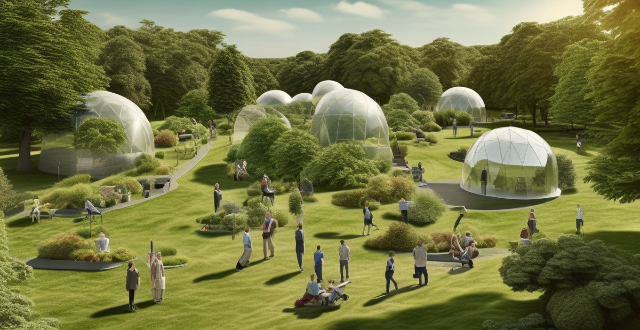The text discusses the importance of environmental psychology in designing green spaces that enhance mental health. It highlights key principles such as biophilia, perceptions of safety, social interaction, cognitive restoration, and sensory experiences. The article suggests incorporating natural elements, defined areas, communal facilities, quiet zones, and multisensory features to create green spaces that promote relaxation, community building, cognitive engagement, and overall well-being.

How Can an Understanding of Environmental Psychology Aid in the Design of Green Spaces that Enhance Mental Health?
Environmental psychology is a field of study that focuses on the interplay between people and their surroundings. It explores how our physical environment affects our emotions, behavior, and cognition. An understanding of environmental psychology can greatly aid in the design of green spaces that enhance mental health. Here's how:
1. Biophilia and Stress Reduction
- Biophilia Hypothesis: The idea that humans have an innate affinity for nature suggests that incorporating natural elements into green spaces can have a positive impact on mental well-being.
- Stress Reduction Theory: Natural environments can reduce stress by providing a sense of escape from daily pressures and promoting relaxation.
Application in Green Space Design:
- Incorporate natural features such as water bodies, vegetation, and rock formations.
- Use materials that mimic natural textures and colors to create a calming atmosphere.
2. Perception of Safety and Comfort
- Territoriality: The concept suggests that people prefer spaces they can claim as their own, which makes them feel safer and more comfortable.
- Prospect-Refuge Theory: This theory posits that people are drawn to locations where they can observe without being observed, offering a balance of curiosity and security.
Application in Green Space Design:
- Create defined areas or zones within the green space to give a sense of ownership and control.
- Design with both open and enclosed spaces to provide options for exploration and refuge.
3. Social Interaction and Community Building
- Social Support Theory: Access to social support networks is crucial for mental health, and public green spaces can facilitate these connections.
- Activity Theory: Engaging in activities, especially those involving nature, can improve mental health by providing a sense of purpose and community involvement.
Application in Green Space Design:
- Include communal areas for gatherings, events, or shared activities like gardening or sports.
- Provide amenities that encourage interaction, such as picnic tables, walking paths, and playgrounds.
4. Cognitive Restoration
- Attention Restoration Theory (ART): Natural environments can help restore directed attention, which is often depleted by prolonged periods of concentration on tasks that require focused attention.
- Cognitive Benefits: Exposure to nature can improve cognitive functioning, including memory, attention, and problem-solving abilities.
Application in Green Space Design:
- Design quiet areas for reflection and contemplation away from noise pollution.
- Incorporate diverse plant species and landscapes to stimulate cognitive engagement and curiosity.
5. Sensory Experiences
- Multisensory Stimulation: Engaging multiple senses through sight, sound, smell, touch, and taste can enhance the overall experience of a green space and contribute to mental well-being.
- Sensory Integration: The integration of sensory experiences can help ground individuals in the present moment, reducing anxiety and promoting mindfulness.
Application in Green Space Design:
- Include elements that appeal to different senses, such as colorful flowers, rustling leaves, fragrance gardens, tactile surfaces, and edible plants.
- Consider the acoustics of the space to incorporate natural sounds like bird songs or flowing water.
In conclusion, an understanding of environmental psychology provides valuable insights into how green spaces can be designed to enhance mental health. By considering factors such as biophilia, perceptions of safety, opportunities for social interaction, cognitive restoration, and sensory experiences, designers can create green spaces that not only beautify urban environments but also promote psychological well-being.